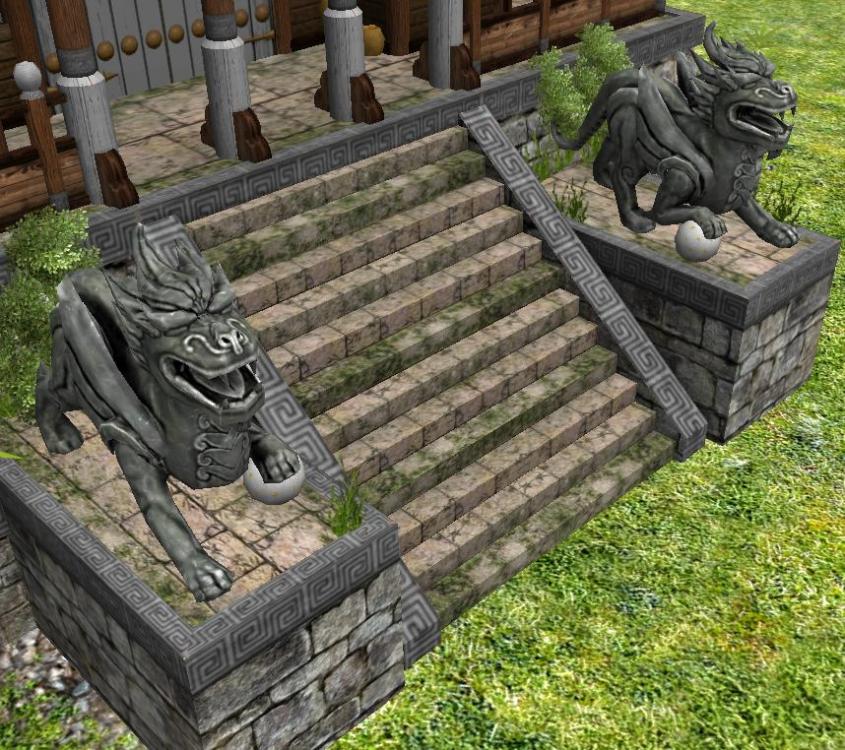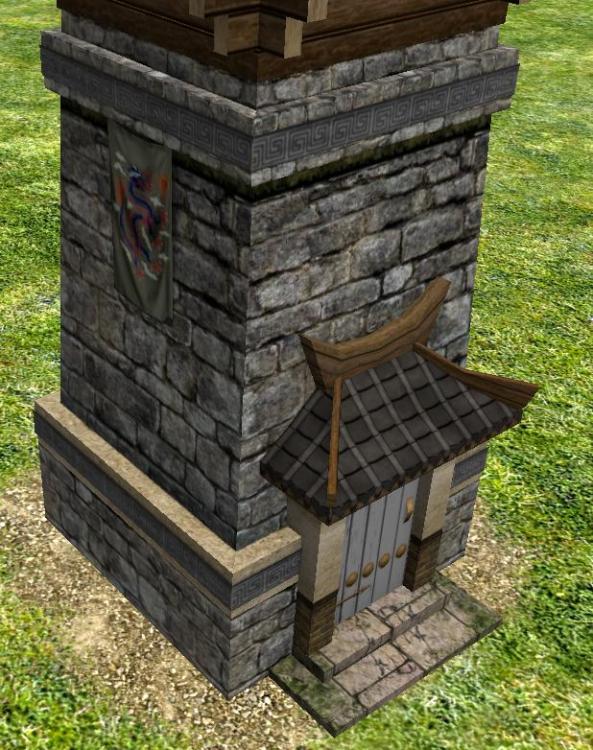-
Posts
2.300 -
Joined
-
Days Won
23
Everything posted by Nescio
-

Addition of Han Chinese to 0AD
Nescio replied to Yekaterina's topic in Game Development & Technical Discussion
The bixie (píxiū) as a mythological animal (a winged lion-griffin-chimaera), yes, that certainly existed in Han China. The Parthians are known to have gifted lions to the Han court, which probably contributed to their popularity. Two more examples of Han statuettes (both under 10 cm), one jade, one bronze: https://www.christies.com/en/lot/lot-6268189 https://www.metmuseum.org/art/collection/search/823655 Bixies as an architectural element is a quite different story, though. Here's how they're used in the 0 A.D. Han mod: One detail that particularly struck me is that stone orb. It's important to realize the dragon, bixie, qilin, and guardian lion are all distinct animals. In more recent times, Chinese guardian lions (shī) were erected in pairs in front of government buildings, the left one the female (yīn) with a cub under her left pawn, the right one the male (yáng) with a cloth ball under its right pawn. I don't know of any bixies with a ball. Nor of large stone animals in front of Han-dynasty government buildings. If you do, please let me know. To summarize, while it's a nice detail, it got the details wrong. I'm not advocating simply removing the stone bixies from the structure: the stone platform and the stone stairs are problematic too. I don't see an easy fix here. -

Addition of Han Chinese to 0AD
Nescio replied to Yekaterina's topic in Game Development & Technical Discussion
Clay? No, rammed earth is a fundamentally different technique than mud brick or adobe. I vaguely recall discussing that in the other thread. The existing structures are not really representative for the Tang dynasty (AD 618–907) either, however, historical accuracy is less important for mods, so feel free to (re)use them in Millennium A.D. Here's a suggestion for an appropiate wonder, the (fired-brick) Giant Wild Goose Pagoda in Xi'an: -

Look of the athenian champions
Nescio replied to Silier's topic in Game Development & Technical Discussion
If the Athenian champion is supposed to be the Iphicratean type, then it shouldn't be called ἐπίλεκτος. The important difference is the peltē is rimless. As for its size, have a look at the east side of the Tomb of Payava from Lycia, c. 360 BC (nowadays in the British Museum): -

Look of the athenian champions
Nescio replied to Silier's topic in Game Development & Technical Discussion
There are probably more examples of elite units looking more impressive than champions in 0 A.D. That's not exactly true: ἐπίλεκτος (plural -οι) simply means ‘chosen’, they were picked troops, selected by the commander to serve as his bodyguard, fight on the right-hand end of the phalanx (the most honourable position), or for some other task. They didn't have some superior equipment that set them apart, nor were they a standing corps. The same is true for the Latin extraordinarii. In Iphicrates' times Greek states increasingly relied on mercenaries, who could be drilled, disciplined, or dismissed, unlike citizens, who were nominally the equals of the leaders and could sue their commanders after the campaign was finished. Moreover, there was more emphasis on mobility, which is why Iphicrates equipped his troops with boots instead of greaves, dropped the bronze muscle cuirass, and replaced the heavy ἀσπίς with the lighter πέλτη (hence the name ‘peltasts’, for what were essentially proto-pikemen). -

Addition of Han Chinese to 0AD
Nescio replied to Yekaterina's topic in Game Development & Technical Discussion
Wood was the primary building material in ancient China and rammed earth was used for platforms and defensive walls. However, the mod's existing tower has stone architecture (as do some other structures), which is wrong (as is that Qing dragon flag): -

Blemmye Desert raider identical to javelin cav?
Nescio replied to Yekaterina's topic in Gameplay Discussion
Having map-specific mercenary camps is something I'd like to see too, and it has been proposed multiple times in the past (e.g. here or here). The suggestion to make embassies prerequisites instead of unit-training structures is interesting too. Anyway, proposals aren't either-or. As with everything, discussions on the forum are nice and all, but what's needed is someone to actually do the work. If nobody creates a patch, nothing would happen. Ranged troops don't get higher resistance or attack damage. Moreover, there is already a technology that makes mercenaries start at advanced rank (added in A22). And keep in mind higher ranks are worse at gathering. Fundamentally the idea is to make mercenaries somewhat in between citizens and champions. -

[reference] Han dynasty Chinese architecture
Nescio replied to Nescio's topic in Tutorials, references and art help
Han model of a two-storey tower: Han model of a three-storey tower: Han model of a four-storey tower: -

Addition of Han Chinese to 0AD
Nescio replied to Yekaterina's topic in Game Development & Technical Discussion
Have a look at this thread. Stone walls, paper lanterns, and Qing dragon flags are some of the things the Han shouldn't have: 0 A.D. is not a Disney film. Perhaps you could start with designing a new fortress or new towers? -

(German) question (yes/no) after starting map - meaning not entirely clear
Nescio replied to Ceres's topic in Bug reports
That's for companies, I suppose (and there is an exemption for free and open-source projects such as 0 A.D.). Individuals can sign up and join projects without having to pay anything: https://www.transifex.com/signup/?join_project=0ad -

(German) question (yes/no) after starting map - meaning not entirely clear
Nescio replied to Ceres's topic in Bug reports
https://www.transifex.com/wildfire-games/0ad/ -

Addition of Han Chinese to 0AD
Nescio replied to Yekaterina's topic in Game Development & Technical Discussion
One thing people love is 0 A.D.'s attention to detail and historical accuracy. Including the Han into A24 was discussed some time ago. It didn't happen. To the best of my knowledge, none of the issues of the Han mod has been solved since. I fail to see why it's suddenly good enough to be included right now. Again, I'd love to see the Han included in game, if possible in A25, and no, not everything has to be perfect. Nevertheless, the most glaring flaws should be addressed first. -

Blemmye Desert raider identical to javelin cav?
Nescio replied to Yekaterina's topic in Gameplay Discussion
There is a proposal to make mercenaries start at advanced rank: https://code.wildfiregames.com/D3699 -
Yes, I fully agree the current situation is far from perfect. Nevertheless, I'm unconvinced limiting player freedom (or breaking the AI) is the way to go.
-
That's actually a depiction of Rome in the 16th C AD, when the city was still much smaller than in Augustan times and people were farming inside the old Roman city walls.
-

Addition of Han Chinese to 0AD
Nescio replied to Yekaterina's topic in Game Development & Technical Discussion
That's actually doable to get committed, A24 had several such changes. I meant art improvements, some examples I've requested more than once on these forums in the past. Britons and Gauls shouldn't have a donkey trader, Athenians and Spartans should. The SQPR ought to be removed from Roman wall textures. The Roman civic centre needs to be replaced. Macedonian dock. Wall towers. I'm fully aware the art team is very small and can't do everything at once. However, when there are already so many things that still need to be improved, I don't think it's wise to include a lot more assets that really need to be replaced. -

Addition of Han Chinese to 0AD
Nescio replied to Yekaterina's topic in Game Development & Technical Discussion
Of course, not everything has to be perfect. However, blatant anachronisms or fantasy elements ought to be avoided. And it's very hard to get something changed once it's in game. -

Addition of Han Chinese to 0AD
Nescio replied to Yekaterina's topic in Game Development & Technical Discussion
While I would love to see the Han included in 0 A.D., I don't think they're ready for inclusion yet. Sure, they're more complete than other candidates, however, they're qualitatively inferior to the civilizations in game. Balance isn't the issue, art is. The mod as is contains things from much later dynasties, such as the Song (AD 960–1279), Ming (1368–1644), and Qing (1636–1912). Furthermore, some structures need to be redesigned (see this thread), a Bactrian camel needs to be added (dromedaries don't live in Central Asia), and unit textures deserve a critical look (currently it's very hard to see the player colour). -

Restrict the Mauryan worker elephant to within its own territory?
Nescio replied to Yekaterina's topic in Gameplay Discussion
Yeah, the higher population cap is problematic. I never liked it and would prefer to see it removed: https://code.wildfiregames.com/D2535 [EDIT]: All civilizations have rams in A24. -

Blemmye Desert raider identical to javelin cav?
Nescio replied to Yekaterina's topic in Gameplay Discussion
How about differentiating camels from cavalry? A proposal: https://code.wildfiregames.com/D3735 -
While I'm not necessarily opposed to realism, I remain unconvinced the proposed solutions are improvements. The easiest option is not always the best one. I don't particularly like it fields are placed around civic centres, however, I already can (and do) build farmsteads at the edge of my starting territory and place fields there. I fail to see what's gained by forcing fields to be moved away.
-

Restrict the Mauryan worker elephant to within its own territory?
Nescio replied to Yekaterina's topic in Gameplay Discussion
For the record, the worker elephant was actually considered not that great in A23 and made cheaper and trained more quickly in A24, but also easier to kill to compensate; see https://code.wildfiregames.com/D2852 -

Differentiating civilizations by economic structures
Nescio replied to Nescio's topic in Gameplay Discussion
As I wrote, it's fine for some factions to share structures. As for cultures, if you mean something along the lines of this forum thread, I don't think that's a good idea: culture is fluid and overlap should be possible, e.g. Iberians having some things in common with Gauls and some with Carthaginians; or Seleucids with Macedonians and with Persians. (I also favour extending the “wooden structures” civilization bonus to the Mauryas, but that's a different discussion.) -

Differentiating civilizations by economic structures
Nescio replied to Nescio's topic in Gameplay Discussion
That would also give more flexibility to modifications that don't want to blindly follow the public standard and allow e.g. removing stone and metal from the civic centre, dock, and worker elephant. -
In 0 A.D. all civilizations have exactly the same basic structures: a house for population, a farmstead for food, a storehouse for other resources, etc. This is basically inherited from Age of Empires, which had a granary (for fruit and grain) and a storage pit (for fish, meat, wood, gold, and stone). Age of Empires II had three structures, a mill (for all food), lumber camp (for wood), and mining camp (for gold and stone). Age of Mythology broke with this convention of all civilizations having the same buildings: The Greeks have a granary for food and a storehouse for wood and gold. The Egyptions have a granary for food, a lumber camp for wood, and a mining camp for gold. The Norse have a movable ox-cart for all resources. The Atlanteans have citizens that double as builders, gatherers, and dropsites and for economic technologies they have an economic guild. The Chinese have a storage pit for food, wood, and gold. This worked great and gave each civilization a different feeling. In principle 0 A.D. could differentiate civilizations by giving them different structures too. With four resources there are already 15 possible combinations for dropsites: a single structure: food+wood+stone+metal two structures: food, wood+stone+metal food+stone+metal, wood food+wood+metal, stone food+wood+stone, metal food+wood, stone+metal food+stone, wood+metal food+metal, wood+stone three structures: food+wood, stone, metal food+stone, wood, metal food+metal, wood, stone food, wood+stone, metal food, wood+metal, stone food, wood, stone+metal a structure for each resource: food, wood, stone, metal Other combinations are possible too (e.g. food+wood, food+stone, food+metal). And combined with the house, corral, and market one can get many more possibilities. Of course, not every single faction must have completely unique structures, it's perfectly fine for multiple civilizations to share similar structures. However, the point is there is no compelling reason why all civilization should continue to always keep exactly the same basic structures. Currently there is a great desire to see 0 A.D.'s civilizations further differentiated from each other. However, the current proposals can fundamentally be summarized as “the same basics + something unique”, which means they'll remain quite similar to each other (as is the case in Age of Empires). By varying the basics instead one could easily achieve a more different feeling for each civilization. What do you think? (As for implementation, someone should improve the AI to use the (already existing) DropsiteFood, DropsiteWood, DropsiteStone, and DropsiteMetal classes instead of Farmstead and Storehouse.)
-
Adding auras or minimum distances is quite easy to implement. The trouble is the AI: Petra does not understand auras, never builds more than one farmstead, and will try to place fields as close as possible to the civic centre. Forcing fields to be moved away from the civic centre thus leads to a poorer single-player experience (and also reduces player freedom). I wonder whether it's worth it. Also keep in mind the multifunctional civic centre isn't entirely realistic either.







